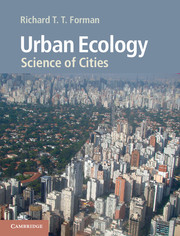Preface
Published online by Cambridge University Press: 05 June 2014
Summary
Preface
Most of us call urb our home. Today’s giant urban areas grow upward in population, with a fast-march outward. Now urban footprints, the agricultural and natural lands needed to sustain us, more than cover the globe. This great urban enterprise thoroughly interacts with ecology, reflecting a yet more powerful force. Nature molds our urban world, from “natural disasters” and resource scarcities to treasured plants and wildlife around us. Even pollutant and waste accumulation, green marketing, and natural landscapes pictured on our walls and in our dreams highlight the ecological dimension. The clashing and collaborating of these two giants – urb and ecology – lead to this book.
My lens focuses on spatial pattern, how it molds and responds to flows/movements, and how they all change. The pattern and process of mosaics, now a centerpiece of ecology from which most other components nicely follow, are central. Indeed, spatial pattern emerges as an especially useful handle for planners, engineers, landscape architects, park managers, pollution experts, architects, transportation specialists, hydrologists, and more. All can easily use the principles of urban ecology to build more-promising futures.
- Type
- Chapter
- Information
- Urban EcologyScience of Cities, pp. xii - xiiiPublisher: Cambridge University PressPrint publication year: 2014



